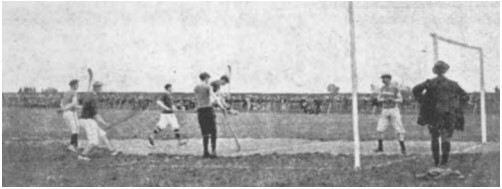By Siobhán Doyle

This hurl was used in the All-Ireland hurling final of 1890, which was the third championship final in GAA history. It is not known which player on the Aghabullogue (Cork) team used the hurl but it was part of a remarkable moment in GAA history for many reasons. The 1890 All-Ireland senior hurling and football finals were due to take place on the same day (16 November) in Clonturk Park, Drumcondra, near what would later become Croke Park. On a day when it was hoped that two teams would be crowned All-Ireland champions, events took a turn and no team took home a title.
The first GAA championships featured club teams who represented their respective counties after winning their county championship. The 1890 finals saw Cork and Wexford qualify in both codes. Cork were represented by Midleton in football and by Aghabullogue in hurling, while Castlebridge and Blue and Whites were the Wexford representatives. The hurling final took place first but the Cork team withdrew from the match because of the Wexford side’s rough play, and it was decided at a committee meeting some weeks later that they be awarded the game and the All-Ireland title.
The football final, due to be played after the hurling match, was postponed owing to the disagreement and the failing light in the November dusk. It was hoped that the match could take place the following day (Monday) but the Wexford contingent had already returned home. The match was refixed for 16 March 1892, but this time it was the Midleton team who refused to play owing to a fair in the town that same day. On 26 June 1892, eighteen months after the game was originally scheduled, the All-Ireland football final was played and Midleton emerged as winners. The victory earned Cork the double on the All-Ireland championship roll of honour but, on deeper reflection, many of the early championship wins were due to walk-overs and abandonment of games and must be interpreted with due suspicion.
This type of longer hurl with a narrow bos is typical of the time, as it is more conducive to ground hurling. Players of the modern game tend to opt for shorter hurls and a wider bos for more control and speed when rising the sliotar one-handed. The hurl is in the collection of the Kilmurry Independence Museum, a volunteer-led museum in the Lee Valley, overlooking what was a hotbed of activity during the revolutionary period. The museum’s first iteration was the Terence McSwiney Memorial Museum, which was opened in a renovated farm building by local history enthusiasts in 1965. The hurl and many more precious artefacts of local and national significance are now housed in the recently purpose-built museum in the heart of Kilmurry village.

This hurl will feature in Siobhán Doyle’s forthcoming book, A history of the GAA in 100 objects (Merrion Press, October 2022).
